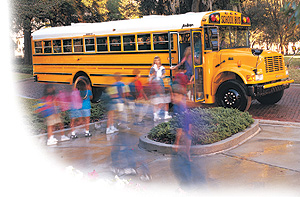NHTSA Position 
- NHTSA recommends that child restraint systems (CRSs) be replaced following a moderate or severe crash in order to ensure a continued high level of crash protection for child passengers.
- NHTSA recommends that CRSs on school buses do not automatically need to be replaced following a
minor crash. - Minor crashes are those that meet ALL of the following criteria:
- The school bus was able to be driven away from the crash site;
- The occupant space inside the school bus near the CRSs was undamaged;
- There were no injuries to any children in CRSs, or serious injury to any other school bus occupant;
- The air bags (if present) did not deploy; AND
- There is no visible damage to the CRSs
Clarifying the need for child seat replacement will reduce the number of children unnecessarily riding without a CRS while a replacement seat is being acquired, and the number of children who will have to ride without a child seat if a seat were discarded and not replaced. The clarification will also reduce the financial burden of unnecessary replacement. Background -
Recent studies demonstrate that child safety seats can withstand minor crash impacts without any documented degradation in subsequent performance. -
The Insurance Corporation of British Columbia (ICBC) subjected nine new and used child seats restraining 3-year-old-child dummies to a series of 50 consecutive 15 km/h sled tests into a 40 percent offset barrier. Three seats were inspected visually; no damage was apparent as a result of the impacts. Three seats underwent x-ray inspection; no damage was detected. Three seats were tested in accordance with Canadian Federal standards (CMVSS 213) and were found to be in compliance with all standards. -
ICBC performed four vehicle crash tests at 48 and 64 km/h, with two child seats restraining 3-year-old- child dummies in each vehicle. Each seat was subjected to multiple impacts and visually inspected.
Defects were noted and the seats were re-tested. Seats always performed as well in subsequent tests as they did in the first test. -
The Insurance Institute for Highway Safety (IIHS) performed 30-mph vehicle crash tests with dummies from six-month-old-child to three-year-old-child types in a variety of child restraint systems (CRSs). Most seats sustained minor damage (e.g., frayed webbing, small cracks in the hard plastic shell, strain-whitening on the plastic shell or chest clip) but all dummies remained well secured by the restraints. Four of the damaged seats were subjected to three additional 30-mph crash tests. Although additional minor damage was observed in subsequent tests, the seats met all Federal standards. -
The agency searched for, but was unable to find, any cases in which a child safety seats were damaged in a minor crash (as defined in NHTSA Position). Note: The agency is committed to maintaining policies that are science-based and data-driven. Stakeholders with data that address post-crash re-use of child safety seats are encouraged to provide this information to the agency. |







